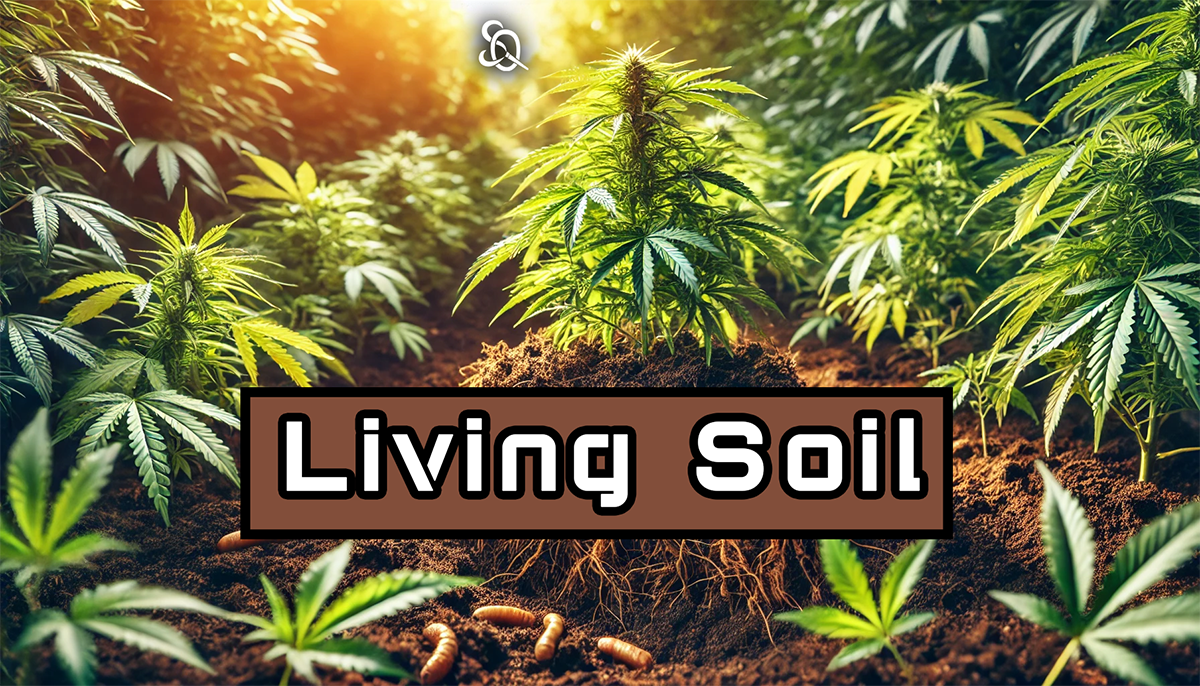Living Soil – The Secret to Healthy Plants

In recent years, the trend towards more natural and sustainable cultivation methods in cannabis cultivation has increased significantly. The concept of Living Soil is particularly popular, as it mimics the biological processes of natural soil, resulting in more resilient and healthier plants. But what exactly is Living Soil, how does it work, and why are more and more growers adopting this method? In this article, you will learn all about the benefits, composition, and the micro- and macroorganisms that make Living Soil so unique.
What is Living Soil?
Living Soil is a dynamic ecosystem that contains not only organic matter and nutrients but also a wide variety of beneficial micro- and macroorganisms. These organisms contribute to an active nutrient cycle by decomposing organic matter and releasing nutrients in a form that plants can absorb. Additionally, many microorganisms form a symbiotic relationship with plant roots, assisting in nutrient uptake while also providing protection against diseases like root rot.
A living soil structure improves substrate texture, optimizes water and nutrient retention, and creates a stable ecological balance. This enables plants to reach their full potential, making them more resilient against diseases and pests while producing higher-quality yields with enhanced flavors and terpene profiles.
Benefits of Living Soil
Living Soil offers numerous advantages for plant cultivation, especially for cannabis. Here are some of the most important benefits:
-
Environmentally Friendly: By avoiding synthetic fertilizers, insecticides, and fungicides, soil life is promoted, and environmental impact is reduced.
-
Improved Soil Health: The diversity of micro- and macroorganisms ensures long-term soil fertility, enhanced structure, and better water retention.
-
Increased Resistance: Beneficial microorganisms in the soil protect plants from diseases and pests by competing with pathogenic organisms and inhibiting their growth.
-
Optimized Nutrient Absorption: Mycorrhizal fungi and other microorganisms enhance the plant’s ability to absorb water and essential nutrients such as nitrogen, phosphorus, and potassium.
-
Reduced Fertilizer Needs: Since nutrients are continuously released from organic matter, reliance on additional mineral fertilizers is significantly lowered.
-
Better Flavor and Aroma: Healthy plants with optimal nutrient availability produce richer flavors and a stronger terpene profile, improving overall harvest quality.
-
Sustainability: Living Soil can be reused for years as it regenerates itself and maintains long-term fertility.
Is Living Soil the Same as Super Soil?
While the terms "Living Soil" and "Super Soil" are often used interchangeably, they have key differences:
-
Living Soil is an active ecosystem containing living microorganisms and macroorganisms that regulate themselves and mimic natural soil balance.
-
Super Soil is a pre-mixed, nutrient-rich soil designed to provide all the necessary nutrients throughout a plant’s lifecycle with only the addition of water.
While Living Soil maintains a natural, self-sustaining system, Super Soil acts as a nutrient-rich substrate, which can be either organic or mineral-based. Both systems aim to grow healthy plants, but they differ in their approach.

How to Make Living Soil
To create an effective Living Soil, various organic components must be combined to establish a fertile and nutrient-rich environment. The following mixture has proven successful:
Mixing Ratios:
-
50% Base Substrate: A blend of peat (30%), coconut fiber (10%), and perlite or vermiculite (10%) provides a loose structure that retains moisture while allowing proper drainage.
-
20% Compost: High-quality, well-aged compost delivers essential nutrients and beneficial microorganisms.
-
20% Worm Castings: A nutrient-dense organic fertilizer that enhances water retention and boosts soil microbiome activity.
-
5% Kelp Meal: A natural source of trace elements and minerals that support plant growth.
-
5% Mineral Additives: Dolomite to regulate pH, rock dust as a long-term nutrient source, and potassium sulfate for optimal potassium supply.
-
Additional Organic Inputs: Plant residues, banana peels, or nettle meal serve as extra nutrient sources and stimulate microbial activity.
-
Molasses: Often added to irrigation water to supply carbohydrates that support microorganism activity.
By combining these components correctly, a balanced substrate is created that not only promotes healthy plants but also strengthens resistance to diseases and pests.
Micro- and Macroorganisms in Living Soil
The most crucial factor for a thriving Living Soil is the presence of living organisms that drive nutrient cycling and improve soil structure. Below are some of the most important micro- and macroorganisms:
Microorganisms
-
Bacteria: Nitrogen-fixing and organic matter-decomposing bacteria release nutrients and protect roots from pathogens.
-
Fungi: Mycorrhizal fungi enhance nutrient absorption and create protective barriers against harmful fungi.
-
Protozoa: Help maintain microbial balance and release nutrients by breaking down other microorganisms.
-
Nematodes: Some nematode species are beneficial, as they combat soil-borne pests and protect the root system.
-
Actinomycetes: Similar to fungi, they break down organic material and produce antibiotic compounds that protect plants from diseases.
Macroorganisms
-
Earthworms: Improve soil structure, aerate the substrate, and leave nutrient-rich castings.
-
Mites and Arthropods: Many of them feed on pests, aiding in natural pest control.
-
Insects: Beetles and other soil insects help decompose organic matter and support nutrient cycling.
-
Cover Crops & Mulch: Living plants or mulch improve soil structure and help retain moisture.
Conclusion
Living Soil is a sustainable and highly effective method for cultivating resilient, healthy plants while preserving environmental balance. By incorporating living microorganisms and organic materials, the soil regenerates itself continuously and remains fertile over the long term. If you are looking for a way to reduce synthetic fertilizers and pesticides while letting nature do the work for you, Living Soil is the ideal solution.
Let nature take care of your plants – for strong growth, aromatic harvests, and a sustainable cultivation system. Happy Harvest!
Recommended Products on Cannadusa
Zauberstaub Organic Solid Fertilizer 10L - 49,00€
BioBizz Starters Pack Soil - 82,00€
Bio Tabs Guerrilla Box - 31,00€
Recent posts
Author
Contents
© 2024 - 2025 Cannadusa. Powered by Medusa Engineering GmbH
• Impressum • AGB • Datenschutz • Compliance

